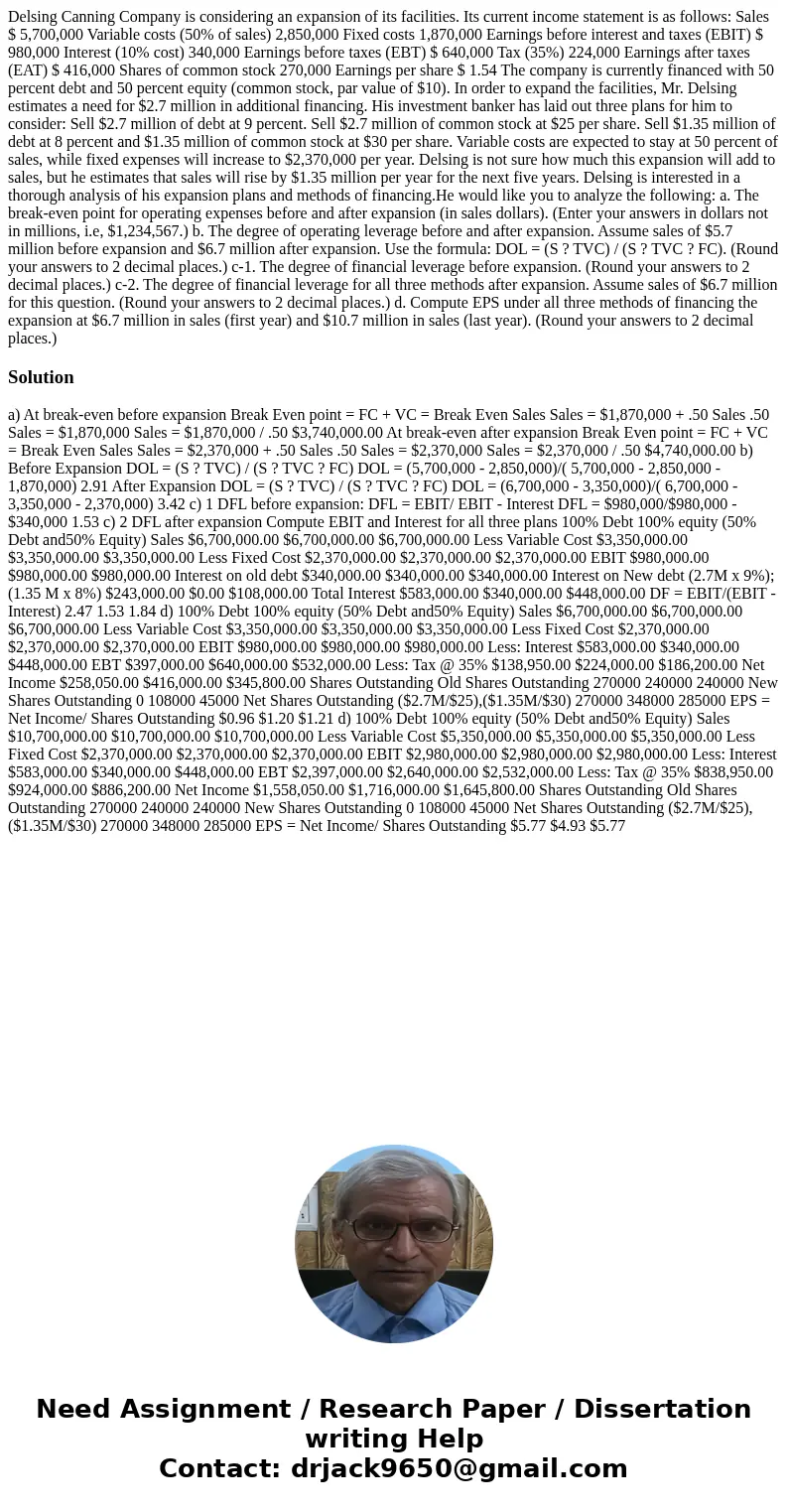Delsing Canning Company is considering an expansion of its f
Delsing Canning Company is considering an expansion of its facilities. Its current income statement is as follows: Sales $ 5,700,000 Variable costs (50% of sales) 2,850,000 Fixed costs 1,870,000 Earnings before interest and taxes (EBIT) $ 980,000 Interest (10% cost) 340,000 Earnings before taxes (EBT) $ 640,000 Tax (35%) 224,000 Earnings after taxes (EAT) $ 416,000 Shares of common stock 270,000 Earnings per share $ 1.54 The company is currently financed with 50 percent debt and 50 percent equity (common stock, par value of $10). In order to expand the facilities, Mr. Delsing estimates a need for $2.7 million in additional financing. His investment banker has laid out three plans for him to consider: Sell $2.7 million of debt at 9 percent. Sell $2.7 million of common stock at $25 per share. Sell $1.35 million of debt at 8 percent and $1.35 million of common stock at $30 per share. Variable costs are expected to stay at 50 percent of sales, while fixed expenses will increase to $2,370,000 per year. Delsing is not sure how much this expansion will add to sales, but he estimates that sales will rise by $1.35 million per year for the next five years. Delsing is interested in a thorough analysis of his expansion plans and methods of financing.He would like you to analyze the following: a. The break-even point for operating expenses before and after expansion (in sales dollars). (Enter your answers in dollars not in millions, i.e, $1,234,567.) b. The degree of operating leverage before and after expansion. Assume sales of $5.7 million before expansion and $6.7 million after expansion. Use the formula: DOL = (S ? TVC) / (S ? TVC ? FC). (Round your answers to 2 decimal places.) c-1. The degree of financial leverage before expansion. (Round your answers to 2 decimal places.) c-2. The degree of financial leverage for all three methods after expansion. Assume sales of $6.7 million for this question. (Round your answers to 2 decimal places.) d. Compute EPS under all three methods of financing the expansion at $6.7 million in sales (first year) and $10.7 million in sales (last year). (Round your answers to 2 decimal places.)
Solution
a) At break-even before expansion Break Even point = FC + VC = Break Even Sales Sales = $1,870,000 + .50 Sales .50 Sales = $1,870,000 Sales = $1,870,000 / .50 $3,740,000.00 At break-even after expansion Break Even point = FC + VC = Break Even Sales Sales = $2,370,000 + .50 Sales .50 Sales = $2,370,000 Sales = $2,370,000 / .50 $4,740,000.00 b) Before Expansion DOL = (S ? TVC) / (S ? TVC ? FC) DOL = (5,700,000 - 2,850,000)/( 5,700,000 - 2,850,000 - 1,870,000) 2.91 After Expansion DOL = (S ? TVC) / (S ? TVC ? FC) DOL = (6,700,000 - 3,350,000)/( 6,700,000 - 3,350,000 - 2,370,000) 3.42 c) 1 DFL before expansion: DFL = EBIT/ EBIT - Interest DFL = $980,000/$980,000 - $340,000 1.53 c) 2 DFL after expansion Compute EBIT and Interest for all three plans 100% Debt 100% equity (50% Debt and50% Equity) Sales $6,700,000.00 $6,700,000.00 $6,700,000.00 Less Variable Cost $3,350,000.00 $3,350,000.00 $3,350,000.00 Less Fixed Cost $2,370,000.00 $2,370,000.00 $2,370,000.00 EBIT $980,000.00 $980,000.00 $980,000.00 Interest on old debt $340,000.00 $340,000.00 $340,000.00 Interest on New debt (2.7M x 9%); (1.35 M x 8%) $243,000.00 $0.00 $108,000.00 Total Interest $583,000.00 $340,000.00 $448,000.00 DF = EBIT/(EBIT - Interest) 2.47 1.53 1.84 d) 100% Debt 100% equity (50% Debt and50% Equity) Sales $6,700,000.00 $6,700,000.00 $6,700,000.00 Less Variable Cost $3,350,000.00 $3,350,000.00 $3,350,000.00 Less Fixed Cost $2,370,000.00 $2,370,000.00 $2,370,000.00 EBIT $980,000.00 $980,000.00 $980,000.00 Less: Interest $583,000.00 $340,000.00 $448,000.00 EBT $397,000.00 $640,000.00 $532,000.00 Less: Tax @ 35% $138,950.00 $224,000.00 $186,200.00 Net Income $258,050.00 $416,000.00 $345,800.00 Shares Outstanding Old Shares Outstanding 270000 240000 240000 New Shares Outstanding 0 108000 45000 Net Shares Outstanding ($2.7M/$25),($1.35M/$30) 270000 348000 285000 EPS = Net Income/ Shares Outstanding $0.96 $1.20 $1.21 d) 100% Debt 100% equity (50% Debt and50% Equity) Sales $10,700,000.00 $10,700,000.00 $10,700,000.00 Less Variable Cost $5,350,000.00 $5,350,000.00 $5,350,000.00 Less Fixed Cost $2,370,000.00 $2,370,000.00 $2,370,000.00 EBIT $2,980,000.00 $2,980,000.00 $2,980,000.00 Less: Interest $583,000.00 $340,000.00 $448,000.00 EBT $2,397,000.00 $2,640,000.00 $2,532,000.00 Less: Tax @ 35% $838,950.00 $924,000.00 $886,200.00 Net Income $1,558,050.00 $1,716,000.00 $1,645,800.00 Shares Outstanding Old Shares Outstanding 270000 240000 240000 New Shares Outstanding 0 108000 45000 Net Shares Outstanding ($2.7M/$25),($1.35M/$30) 270000 348000 285000 EPS = Net Income/ Shares Outstanding $5.77 $4.93 $5.77
 Homework Sourse
Homework Sourse